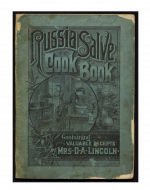Created by Kat Payne on Mon, 11/01/2021 - 16:49
Description:
From the "Food and Drink in History" database: https://www.foodanddrink.amdigital.co.uk/Documents/Images/NYAM_306810209...
This image is the cover of a Russian cookbook that was published in the year 1885 and written by Mrs. D. A. Lincoln. Russia harbors an excruciatingly harsh climate as it is frigid and dark for the majority of the year; thus, the rough environment makes it difficult for any produce to grow. Only certain plants are able to grow in the dense, cold soil; one of these plants is rye.
Rye is similar to wheat, except that rye is hardier than wheat and is able to withstand Russia's climate. Rye was one of the many peculiar pieces of produce that were abundantly available to the people of Soviet Russia. This allowed for bread to be popular; thus, the first section of the Russian Salve Cookbook covers foods that originate from rye, such as different types of breads from loaves, to muffins, and to scones. For many citizens of Soviet Russia who were not as lucky as most, slices of rye bread or rye cereal—such as porridge—were all common breakfast foods. Many of the recipes from the Russian Salve Cookbook includes rye meal as many of the primary ingrediants; some example recipes include raised brown bread and rye short-cake toast. Many of the recipes included in this text could be deemed as breakfast foods, since there are waffles, doughnuts, eggs, and the like; however, this cookbook was more than likely to be publicized toward the more fortunate citizens of Soviet Russia, who had access to all of these ingrediants. Even so, the ingrediants included in these breakfast recipes are very few; thus, they are not extremely difficult to cook. Additionally, the cookbook also includes a plethora of soups, which were a staple lunch and dinner meal in Russian households. Nothing was more sought after than a steaming hot bowl of soup after trecking through the snowy outdoors. Many vegetables were capable of withstanding the weather; a few examples of these brave vegetables include potatoes, radishes, and celery. Borsch and shchi are two well-known Russian soups. Borsch is extremely popular because of it's strange purple and red hue derived from the radishes that it is made from. The cookbook was most likely based around the foods that could be discovered in large Russian cities such as its capital, Moscow, or Saint Petersburg (then Leningrad.) However, even though rye meal was widely available across the country, these more populated cities and the Russian aristocracy were able to indulge in wheat flour, which was the more tasty cousin of rye. Russians who lived outside of these densely-populated zones—especially in the northern part of the country—were never able to indulge in delicious wheat flour.
The Russian Salve Cookbook provides insight into how the more fortunate people of Russia back in the year 1885 and what foods were commonly consumed, such as bread and/or porridge for breakfast, and soup for either lunch or dinner; even though it was difficult for vibrant fruits to grow in Russia, its citizens were able to make use of the vegetables and rye that were available to them and create delicious and simple recipes.
Works Cited
Butler, Jennifer. “The History of Russian Cuisine.” Express to Russia, Express to Russia, 19 May 2021, https://www.expresstorussia.com/experience-russia/the-history-of-russian...
Lee, Alexander. “From Russia with Borscht.” History Today, 8 Aug. 2018, https://www.historytoday.com/archive/historians-cookbook/russia-borscht.
Lincoln, Mary J. Russia. Salve Cookbook. 1885.
“Mary J. Lincoln Teaches America How to Make Brown Bread, Baked Beans, Fish Balls and Indian Pudding.” New England Historical Society, 3 Dec. 2014, https://www.newenglandhistoricalsociety.com/mary-j-lincoln-teaches-ameri....
Wengorz, Vladimir, and Viktoria Klusch. “Baking with Rye Flour in Russia.” World Grain RSS, 16 Apr. 2021, https://www.world-grain.com/articles/15157-baking-with-rye-flour-in-russia.
Copyright:
Associated Place(s)
Part of Group:
Featured in Exhibit:
Artist:
- Mrs. D. A. Lincoln


